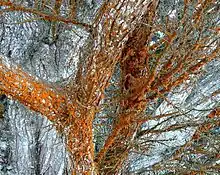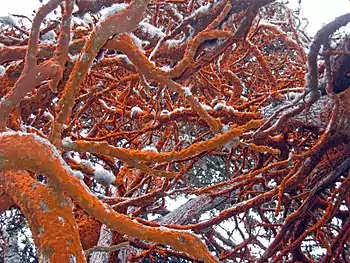Trentepohlia aurea
Trentepohlia aurea is a species of filamentous terrestrial green alga with a worldwide distribution. It grows on rocks, old walls and the trunks and branches of trees such as oaks and the Monterey cypress (Cupressus macrocarpa) where the tree occurs in coastal central California. The orange coloration results from carotenoid pigments in the algal cells. It is probably the most widespread and abundant species of Trentepohlia in the Britain and Ireland.[2]:478
| Trentepohlia aurea | |
|---|---|
 | |
| Trentepohlia aurea on Monterey cypress, Morro Bay State Park | |
| Scientific classification | |
| Phylum: | Chlorophyta |
| Class: | Ulvophyceae |
| Order: | Trentepohliales |
| Family: | Trentepohliaceae |
| Genus: | Trentepohlia |
| Species: | T. aurea |
| Binomial name | |
| Trentepohlia aurea (L.) | |
| Synonyms [1] | |
| |
References
- Michael D. Guiry (2015). Guiry MD, Guiry GM (eds.). "Trentepohlia aurea (Linnaeus) C.F.P.Martius, 1817". AlgaeBase. National University of Ireland, Galway. World Register of Marine Species. Retrieved 9 February 2016.
- John, D.M.; Whitton, B.A.; Brook, A.J. (2002). The freshwater algal flora of the British Isles: an identification guide to freshwater and terrestrial algae. Cambridge, U.K.: Cambridge University Press. ISBN 978-0521770514.
External links
 Media related to Trentepohlia aurea at Wikimedia Commons
Media related to Trentepohlia aurea at Wikimedia Commons

Trentepohlia aurea var. polycarpa at Point Lobos State Reserve. The orange color is from one of the pigments, beta carotene.
This article is issued from Wikipedia. The text is licensed under Creative Commons - Attribution - Sharealike. Additional terms may apply for the media files.